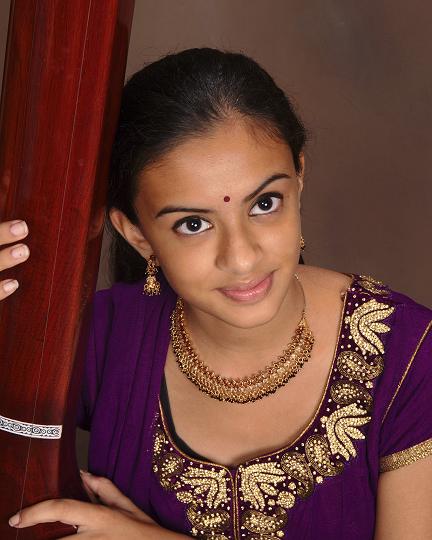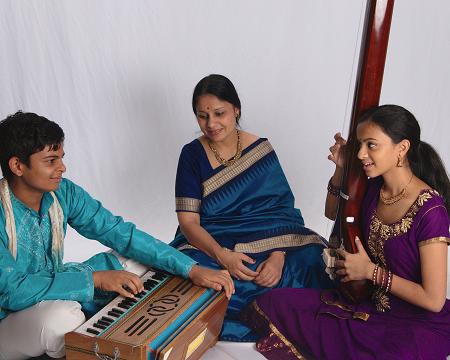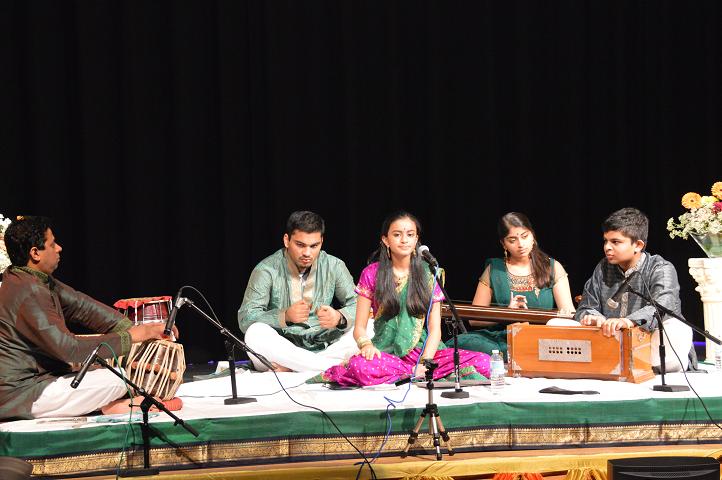Contribute
| Radha And Rohit Rao’s Manch Pravesh: Sustaining A Traditional Legacy |
Deepti Navaratna
02/13/2014
Perhaps one of the most rewarding moments in the sustenance of a tradition is when one finds that its ageless wisdom continues to illuminate a new generation - providing them with a secure legacy to engage with the world of sound. Radha Rao’s Manch Pravesh on Saturday, January 11 at Sharon Middle School mirrored one such success. Daughter and student of Bhaskar Rao and Smt. Shuchita Rao, a well known teacher and performer of North Indian classical music (Hindustani music), Radha’s recital was an affirmation that, with the right exposure and environment – the baton of continuity is in safe hands. Manch Pravesh is the debut full-length solo performance featuring North Indian music commonly referred to as Hindustani music. Radha presented eleven compositions based on a variety of ragas suitable to be performed during the evening and night. In addition to classical fare of Khayal, she also presented semi-classical items such as taraana, thillana, bhajan, abhang, Bollywood song and an American folk song.
Radha began the program at 4:30pm with a prayer in praise of Goddess Saraswati. The opening Sanskrit shloka in raag Puriya Dhanashri was composed by her mother and Guru, Smt. Shuchita Rao. Radha chose to present Bada khayal (slow tempo khayal) in Raag Bhoop for her main classical piece. The lyrics, “Eri aaj sukha†described the happiness the poet experienced upon seeing his beloved. Using her imagination, Radha spontaneously improvised and presented alaaps and taans that brought out the essence of Bhoop. A composition popularized by late Pandit Kumar Gandharva, “Abeer Gulaal†describing the colorful festival of Holi came next. The rendition of Raag Bhoop was concluded by “Maano Maano Muraariâ€, a drut khayal (fast paced composition) describing a gopika’s plea to Lord Krishna to spare her of his naughty nature. A Madhyalaya Khayal (medium tempo Khayal) “Ha Peer†in Raga Dhani set to 10 beat cycle Jhaptaal describing the greatness of Saint Nizamuddin Auliya came next. It was followed by a drut khayal, “Sakhi Maanat Naahi†set to 16 beat cycle teentaal .
An interesting juxtaposition of a Carnatic Thillana (composition that uses rhythmic syllables) composed by Maharaja Swati Thirunal in Raaga Dhanasri was contrasted with a Hindustani Tarana in Raga Bhimpalasi. The sequential presentation of the similar compositional types in Carnatic and Hindustani music was a commendable idea and was executed to great effect. Perhaps the most challenging and unique piece of the program was the Raagamala, (a garland of raagas) as it wove together 13 different raagas. Originally popularized by Malini Rajurkar, it is a tough piece that demands great vocal dexterity with rapid raga changes; a tough composition to pull off for a debutant. Radha excelled in bringing out the contrasting soundscapes of the raagas, with great confidence and vigor. Radha has a powerful and clear voice with a great vocal range. In the years to come, her musical maturity in creating an evocative performance through word and raga can only get better.
In the second half, Radha began with a traditional American folk song from the 1950s titled “ House of the Rising Sunâ€. It told the story of a life gone wrong in New Orleans. Rohit Rao accompanied Radha on piano and Abhiram Rao accompanied her on the Octopad. This was followed by “Moula Mere Le Le Meri Jaan†set to Raaga Charukesi and to 14 beat cycle Deepchandi , a hindi song from 2007 Bollywood film “Chak De India†was the next item to be performed. Interesting to quote Radha at this juncture: ‘I see myself as using my foundation in Hindustani music as a base to explore Western music genres such as Jazz, R&B, Gospel, Soul and Pop music.’ Beyond the imminent danger one perceives in the zest to think puritan, it is heartening to see how she views her tradition as a springboard to engage with a world full of sonic beauty. To break the spell of vocal renditions, Rohit Rao played a short instrumental solo in Raag Jog on the harmonium. The interplay of sharp and flat gandhaar musical notes created a solemn and beautiful atmosphere. Rajesh Pai on tabla showcased his energetic and sensitive tabla playing skills in a drum solo at the end of this piece. Minerva Teli accompanied on taanpura and Abhiram Rao provided additional support on percussion.
Radha concluded her Manch Pravesh recital with two devotional compositions. A Kabeer Bhajan in Raag Madhukauns “Saheb hai Rangrez†described GOD as an expert dye master who had the ability to remove the dark stains from our veils and give them the color of love. In a Marathi abhang “Teertha Vitthala Kshetra Vitthalaâ€, poet Naamdev described our consciousness to be present in holy waters, in places of worship, in the mother, in the father, in the Guru and his master, in the lineage and in eternity. Radha ended her recital with a peace invocation in Sanskrit from the Isha Upanishad, “Om Poornamadaha, Poornamidam, Poornaat, Poornamudacchyate, Poornasya, Poornamaadaya, Poornamevaavashishyate. Om Shantih Shantih Shantihâ€
‘We share a musical bond’ quips a proud mother, in trying to describe what music means to their family. Shuchita Rao speaks fondly of the transformative experience that has come her way while tutoring two very keen learners at home. She believes that sharing and teaching music to a generation that is unafraid to challenge traditional imperatives has shaped her attitudes about innovation within and without a traditional paradigm. The event was well attended by music lovers in the New England area, who left with a happy anticipation of many more such recitals in the future.
You may also access this article through our web-site http://www.lokvani.com/


